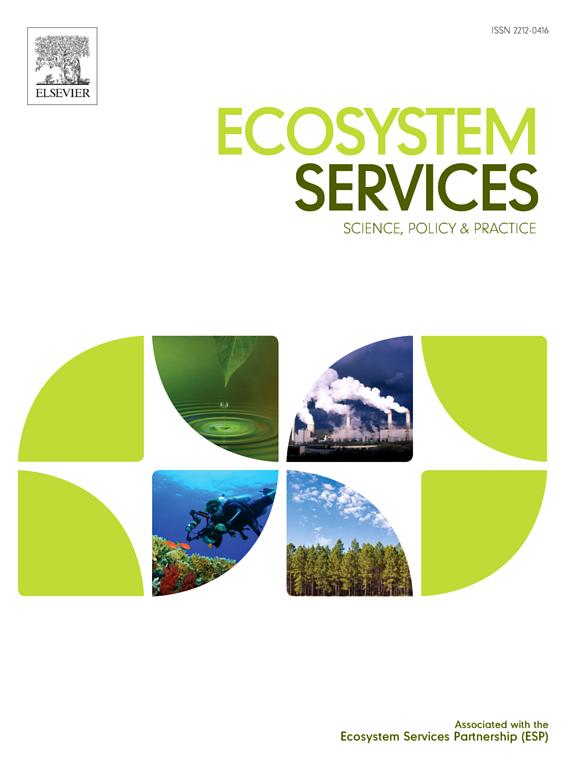老挝Savannakhet省生态系统服务供需空间格局研究
IF 6.6
2区 环境科学与生态学
Q1 ECOLOGY
引用次数: 0
摘要
本文从空间上评估了老挝萨凡那切省不同景观中关键生态系统服务(ES)的供需情况。本文采用InVEST模型和空间统计方法建立了ES供给模型,并通过调查对ES需求进行了评估。分析了生态系统供给和需求的空间分布,并分别确定了生态系统总体供给和生态系统需求的空间热点和冷点。此外,我们得出了ES之间的协同效应和权衡。所有的分析都与生态分区、社会经济导向、保护工作和偏远有关。我们的研究结果表明,在森林和轮作系统比例较高的地区,ES的供应相对较高,但在西部低地,ES食品的供应相对较高,水稻和农业的总体比例较高。与供应相比,ES的需求在全省的分布要均匀得多。我们发现了食物和物种之间的轻微权衡。发现了水质、水和旅游业的协同效应。生态系统供应热点出现在使用强度较低的景观中,主要是在健康、功能良好的生态系统中,而生态系统供应冷点则出现在城市附近。在所有景观中都发现了需求热点。需求冷点位于城市和偏远地区或保护区。ES的供给沿生态梯度增加,但食物的供给减少。ES需求沿生态梯度呈下降趋势。生态系统供应因指标和景观类型而异,而生态系统需求似乎在景观和人们的社会经济取向之间更为平衡。我们的研究结果强调了维护多功能景观的重要性,这些景观正在迅速转变为强烈使用的单一文化。这里提出的基线可以指导干预措施,以改善对萨凡纳赫特那些可能在满足土地使用者需求方面产生最佳结果的地方的ES供应。本文章由计算机程序翻译,如有差异,请以英文原文为准。
Understanding spatial patterns of ecosystem service supply and demand in Savannakhet Province, Laos
We spatially assess supply of and demand for key ecosystem services (ES) across the diverse landscapes of Savannakhet province in Laos. We used InVEST models and spatial statistics to model ES supply, and assessed ES demand by means of a survey. We analyse the spatial distribution of ES supply and demand, and identify spatial hot and cold spots of overall ES supply and ES demand, respectively. In addition, we derive synergies and trade-offs among ES. All analyses are conducted in relation to ecological zonation, socio-economic orientation, conservation efforts, and remoteness. Our results suggest that ES supply is relatively high in areas with high shares of forest and shifting cultivation systems, except the supply of the ES Food, which is relatively high in the western lowlands, with high shares of paddy rice and agriculture in general. Compared to supply, ES demand is much more evenly spread throughout the province. We identified a slight trade-off between Food and Species. Synergies were found for Water quality, Water, and Tourism. ES supply hotspots are found in less intensely used landscapes, mainly in healthy, well-functioning ecosystems, while ES supply cold spots occur near urban areas. Demand hotspots are found in all landscapes. Demand cold spots are found in urban and in remote or protected areas. ES supply increases along the ecological gradient, except for Food, which decreases. ES demand tends to decrease along the ecological gradient. ES supply varies widely by indicator and landscape type, while ES demand seems more balanced across landscapes and peoples’ socio-economic orientation. Our results underline the importance of maintaining multifunctional landscapes, which are rapidly transforming into intensely used monocultures. The baseline presented here can guide interventions to improve ES supply towards those places in Savannakhet where they might yield the best outcome in terms of satisfying land users’ demands.
求助全文
通过发布文献求助,成功后即可免费获取论文全文。
去求助
来源期刊

Ecosystem Services
ECOLOGYENVIRONMENTAL SCIENCES&-ENVIRONMENTAL SCIENCES
CiteScore
14.90
自引率
7.90%
发文量
109
期刊介绍:
Ecosystem Services is an international, interdisciplinary journal that is associated with the Ecosystem Services Partnership (ESP). The journal is dedicated to exploring the science, policy, and practice related to ecosystem services, which are the various ways in which ecosystems contribute to human well-being, both directly and indirectly.
Ecosystem Services contributes to the broader goal of ensuring that the benefits of ecosystems are recognized, valued, and sustainably managed for the well-being of current and future generations. The journal serves as a platform for scholars, practitioners, policymakers, and other stakeholders to share their findings and insights, fostering collaboration and innovation in the field of ecosystem services.
 求助内容:
求助内容: 应助结果提醒方式:
应助结果提醒方式:


